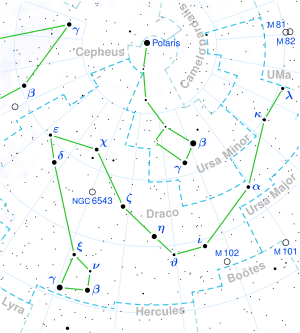Gliese 687
Coordinates:  17h 36m 25.8999s, +68° 20′ 20.909″
17h 36m 25.8999s, +68° 20′ 20.909″
| Observation data Epoch J2000 Equinox J2000 | |
|---|---|
| Constellation | Draco |
| Right ascension | 17h 36m 25.8999s[1] |
| Declination | +68° 20′ 20.909″[1] |
| Apparent magnitude (V) | 9.15[2] |
| Characteristics | |
| Spectral type | M3.5 V[3] |
| U−B color index | 1.06 |
| B−V color index | 1.49 |
| Absolute magnitude (MV) | 10.87 |
| Details | |
Rotational velocity (v sin i) | <2.8[9] km/s |
| Database references | |
| SIMBAD | data |
Location of Gliese 687 in the constellation Draco | |
Gliese 687, or GJ 687 (
Properties
Gliese 687 has about 40% of the Sun's mass and nearly 50% of the Sun's radius. Compared to the Sun, it has a slightly higher proportion of elements with higher atomic numbers than helium.[6] It seems to rotate every 60 days and exhibit some chromospheric activity.
It displays no excess of infrared radiation that would indicate orbiting dust.[11]
Planetary system
In 2014, it was discovered to have a planet,
Gliese 687 b, with a minimum mass of 18.394 Earth masses (which makes it comparable to Neptune), an orbital period of 38.14 days, a low orbital eccentricity and inside the habitable zone.[8] Another Neptune mass planet candidate was discovered in 2020, in a further out and much colder orbit.[12]
| Companion (in order from star) |
Mass | Semimajor axis (AU) |
Orbital period (days) |
Eccentricity | Inclination | Radius |
|---|---|---|---|---|---|---|
b
|
≥17.2 M🜨 | 0.163 | 38.142 | 0.17 | — | — |
c
|
≥16 M🜨 | 1.165 | 727.562 | 0.40 | — | — |
X-ray source
Gliese 687 is a solitary red dwarf that emits X-rays.[13]
See also
- List of nearest stars and brown dwarfs
- List of exoplanets discovered in 2014 - Gliese 687 b
- List of exoplanets discovered in 2020 - Gliese 687 c
References
- ^ Bibcode:1997A&A...323L..49P.
- ^ Centre de Données astronomiques de Strasbourg. Retrieved 2009-11-12.
- S2CID 14461746.
- Bibcode:1967IAUS...30...57E.
- .
- ^ S2CID 14966363.
- ISSN 0004-637X.
- ^ S2CID 17668957.
- S2CID 119203469.
- .
- S2CID 15732144.)
{{cite journal}}: CS1 maint: multiple names: authors list (link - ^ )
- doi:10.1086/176149.


